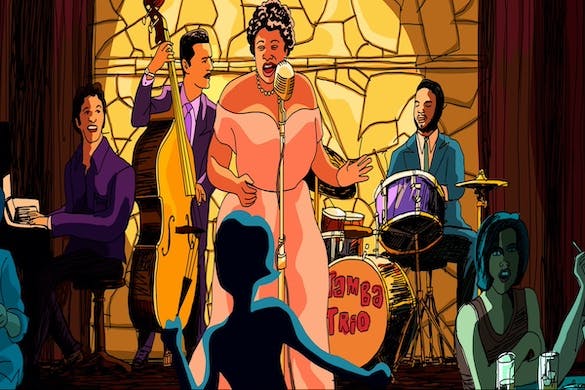Set to a Brazilian Beat, ‘They Shot the Piano Player’ Swings, Saddens, and Surprises
An adult animated picture, the movie is at once a documentary about the writing of a book, a short history of bossa nova, a biographical portrait of a forgotten musician, and more.

At the start of the new movie “They Shot the Piano Player,” the following words and names are among those that flash colorfully on the screen: Bossa Nova, Jazz, Samba, Antônio Carlos Jobim, Ella Fitzgerald, Bill Evans. With its infectious soundtrack, the film will clearly take aficionados of Brazilian music and jazz back to when they first started their love affairs with the genres.
Yet even for those viewers not versed in their various rhythms and melodies, the movie will entertain and edify, primarily due to its appealing use of animation to tell a story of music, mystery, and, tragically, murder.
First and foremost an adult animated picture, the movie is also much more: a documentary about the writing of a book, a short history of bossa nova, a glimpse at the geopolitical issues of mid-20th century Central and South America, and a biographical portrait of a forgotten musician. That musician is Tenório Júnior, a Rio-based pianist and composer who disappeared in 1976 while on tour in Argentina. It’s Tenório’s story that gives the film both its momentum — beyond a music doc’s chronology — and the stultifying passages of its second half.
Our guide through the thicket of the movie’s topics is a New Yorker writer, Jeff Harris, who is voiced by another Jeff, the actor Goldblum. During a book signing at the Strand Bookstore, Jeff Harris explains how he was initially tasked with authoring a book on bossa nova yet soon became obsessed with Júnior, one of its practitioners. From there, the film dives into his research as it took him to Rio and elsewhere to interview performers and poets from the golden years of Brazilian music.
This first half of “They Shot the Piano Player” positively pulses with jazzy samba moments. Artist, designer, and director Javier Mariscal illustrates these scenes with hand-drawn figures and settings augmented by computer graphics. Along with co-director Fernando Trueba, they fill the frame with color and movement, much as they did in their Oscar-nominated animated film “Chico and Rita” from 2011.
While watching, one senses the freedom that animation gives them to convey the music’s essence, how it opens up expressive possibilities not easily attainable through live action or interviewee-based documentary, particularly in sequences that recreate the Rio of the 1950s and ’60s bathed in modernist design and voluptuous vibes. At the same time, the viewing experience can be occasionally overwhelming with the cavalcade of musicians, intermittent subtitles, twitchy animation, sublimely distracting art direction, allusions to French nouvelle vague classics, amusing by-play, and more.
Eventually, though, the story of the birth and development of bossa nova, told through the songs and authentic reminisces of musical icons like Jobim and João Gilberto, takes a backseat to the search for answers regarding Tenório. As Jeff meets his compatriots and loved ones, he pieces together what might have occurred the night he went missing.
Prior knowledge of the coups in Argentina and Brazil will help to contextualize the era’s unstable political situation, but the film does offer an interlude that literally maps out the unrest in those countries and neighboring ones. It even mentions “Operation Condor,” the covert campaign of social and political repression in South America by right-wing forces backed by the U.S.
A trip to Buenos Aires leads Jeff to get closer to the truth of what happened to Tenório in March 1976. Despairing stories of people “disappearing” during the Argentine coup d’état place a definite chill on what started off as warmly discursive cinema. Ironically, just as we learn more of his fate, the film’s power starts to dip back instead of spring forward, with some events in the timeline of the pianist’s life and disappearance getting lost or repeated in the surge of information.
The animated atmosphere does turn tense when the filmmakers pair an interview of a man with firsthand knowledge of what happened with a noirish re-creation, but it’s nearly redundant by that point.
There’s no denying that Mr. Trueba, who wrote the screenplay, and Mr. Mariscal have done something slyly subversive: hidden a dark history lesson within a celebratory nostalgia trip. During the process, they’ve brought the story of an unsung artist to a wider audience, though one can’t help but wish they had focused a bit more on his artistry than his vanishing. Vibrant music sequences, like one earlier in the movie in which the recording of the instrumental “Embalo” is depicted, are what remain on the retina and continue to sing in the ear afterwards.
Surprisingly, the filmmakers have also performed something of a hat trick by including invented elements in what is ostensibly a documentary. I realized this as I watched the closing credits and the words “fictional characters” appeared. Because the press notes make no reference to these, a quick web search disabused me of the idea that the framing device employed was based on real people. With this realization came another: The film, then, is not merely factual but also a form of magical thinking, spreading the essential truth and beauty of Tenório’s life and times when no one else will.

